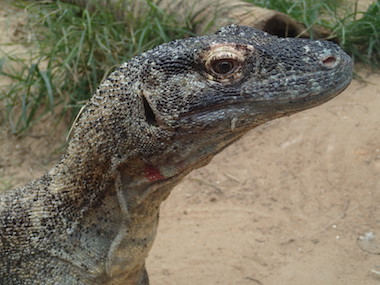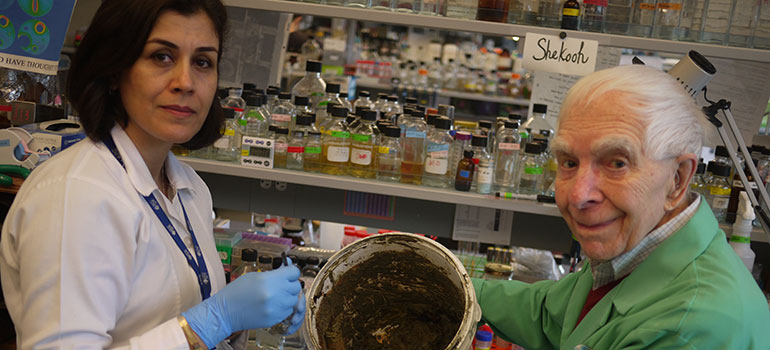Staphylococcus aureus
See the following -
'Big Chicken': The Medical Mystery That Traced Back To Slaughterhouse Workers
Reimert Ravenholt, a physician at the Seattle Department of Public Health, was puzzled. It was the winter of 1956, and for weeks now, local doctors had been calling him, describing blue-collar men coming into their offices with hot, red rashes and swollen boils running up their arms. The men were feverish and in so much pain they had to stay home from work, sometimes for weeks...
- Login to post comments
Antimicrobial Substances Identified in Komodo Dragon Blood
 In a land where survival is precarious, Komodo dragons thrive despite being exposed to scads of bacteria that would kill less hardy creatures. Now in a study published in the Journal of Proteome Research, scientists report that they have detected antimicrobial protein fragments in the lizard’s blood that appear to help them resist deadly infections. The discovery could lead to the development of new drugs capable of combating bacteria that have become resistant to antibiotics...
In a land where survival is precarious, Komodo dragons thrive despite being exposed to scads of bacteria that would kill less hardy creatures. Now in a study published in the Journal of Proteome Research, scientists report that they have detected antimicrobial protein fragments in the lizard’s blood that appear to help them resist deadly infections. The discovery could lead to the development of new drugs capable of combating bacteria that have become resistant to antibiotics...
- Login to post comments
By 2050, Superbugs Will Kill 10 Million People A Year
A scourge is emerging across the rich and poor worlds alike, one that will claim 10 million lives a year by mid-century. Watch out for the “superbugs”—pathogens that even antibiotics can’t kill...
- Login to post comments
First Nations’ Ancient Medicinal Clay Shows Promise Against Today’s Worst Bacterial Infections
 Naturally occurring clay from Kisameet Bay, B.C. — long used by the Heiltsuk First Nation for its healing potential — exhibits potent antibacterial activity against multidrug-resistant pathogens, according to new research from the University of British Columbia. The researchers recommend the rare mineral clay be studied as a clinical treatment for serious infections caused by ESKAPE strains of bacteria...
Naturally occurring clay from Kisameet Bay, B.C. — long used by the Heiltsuk First Nation for its healing potential — exhibits potent antibacterial activity against multidrug-resistant pathogens, according to new research from the University of British Columbia. The researchers recommend the rare mineral clay be studied as a clinical treatment for serious infections caused by ESKAPE strains of bacteria...
- Login to post comments
New Arms Race: Science Versus Antibiotic-Resistant Superbugs
 The death rate from bacterial infections plummeted following the discovery of penicillin. However, these microbes developed ways to resist our antibiotics. What threats do superbugs pose and what factors contribute to their emergence? The discovery and development of antibiotics saved millions of lives during the latter half of the 20th century. Scottish bacteriologist Alexander Fleming, who witnessed soldiers with infected wounds perish while serving in the Royal Army Medical Corps during the First World War, per chance discovered a penicillin producing mold in 1928...
The death rate from bacterial infections plummeted following the discovery of penicillin. However, these microbes developed ways to resist our antibiotics. What threats do superbugs pose and what factors contribute to their emergence? The discovery and development of antibiotics saved millions of lives during the latter half of the 20th century. Scottish bacteriologist Alexander Fleming, who witnessed soldiers with infected wounds perish while serving in the Royal Army Medical Corps during the First World War, per chance discovered a penicillin producing mold in 1928...
- Login to post comments
Revolutionary New Antibiotic Alternative Could Save The World From Superbug 'Apocalypse'
Scientists have developed a new alternative to antibiotics that could revolutionise the way we treat superbugs and avoid a scenario where common medical procedures become life-threatening due to bacteria becoming immune to conventional drugs...
- Login to post comments
The Grim Propect of Antibiotic Resistance
 When people hear about antibiotic resistance creating “superbugs”, they tend to think of new diseases and pandemics spreading out of control. The real threat is less flamboyant, but still serious: existing problems getting worse, sometimes dramatically. Infections acquired in hospital are a prime example. They are already a problem, but with more antibiotic resistance they could become a much worse one. Elective surgery, such as hip replacements, now routine, would come to carry what might be seen as unacceptable risk. So might Caesarean sections. The risks of procedures which suppress the immune system, such as organ transplants and cancer chemotherapies, would increase...
When people hear about antibiotic resistance creating “superbugs”, they tend to think of new diseases and pandemics spreading out of control. The real threat is less flamboyant, but still serious: existing problems getting worse, sometimes dramatically. Infections acquired in hospital are a prime example. They are already a problem, but with more antibiotic resistance they could become a much worse one. Elective surgery, such as hip replacements, now routine, would come to carry what might be seen as unacceptable risk. So might Caesarean sections. The risks of procedures which suppress the immune system, such as organ transplants and cancer chemotherapies, would increase...
- Login to post comments